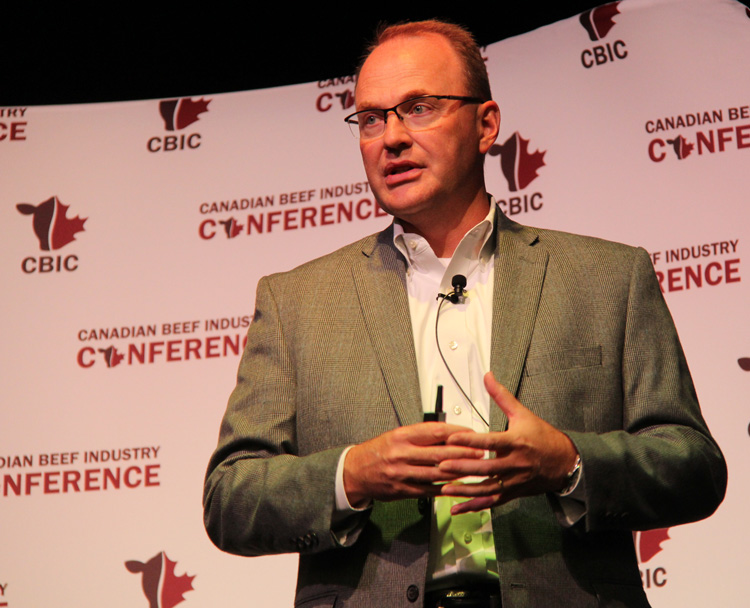
Agricultural News
Business in Reverse - Planning Herd Genetics Based on Consumer Desires
Mon, 15 Aug 2016 17:19:08 CDT
 Cattlemen have focused on quality from the beginning. Their success at delivering cattle that perform for the next owner kept them in business through market ups and downs. The approach seems to work, but can it keep working in an era of relatively higher beef prices?
Cattlemen have focused on quality from the beginning. Their success at delivering cattle that perform for the next owner kept them in business through market ups and downs. The approach seems to work, but can it keep working in an era of relatively higher beef prices?
Mark McCully, vice president of production for the Certified Angus Beef ® brand (CAB®), challenged producers at the inaugural Canadian Beef Industry Conference to consider looking at their business in reverse.
"We know genetics are important," he said. "We know health management is important at the ranch and at the feedyard - but they're also critically important to consumer satisfaction, which ultimately drives demand for that product."
And that, he said, brings profitability to the whole system.
"Let's start with the consumer and work our way backwards," McCully said in the August 11 presentation in Calgary, Alta. "That's how we will most effectively hit the consumer target."
Showing a perfectly grilled and plated steak, he encouraged ranchers and feedyard operators to evaluate how their management decisions affect the end product. He reminded everyone that marbling is the basis of quality grading systems and highly correlated to consumer satisfaction.
"Adding that takes nothing away from cow herd performance but adds much to the value of the end product," he said.
Improved marbling starts with genetics, as carcass traits are highly heritable. McCully shared data from the USDA Meat Animal Research Center that shows Angus cattle surpass all other breeds in ability to marble, even though there is much variation within all breeds.
That's why producers use expected progeny differences (EPDs) as comparison tools, he said, noting recommendations in CAB's "Best Practices Manual" available online. DNA-based tools can also help select heifers with increased marbling potential.
Once calves are born, beef quality is maximized with proper care.
"It boils down to what those things are that impact marbling," McCully said. "Health and management, nutrition and creep feeding in particular. Know and be aware that the nutritional management of the calf while he's still on the cow can affect weaning, and that calf's marbling ability."
A slide of a steer chasing men over a cliff demonstrated the importance of selecting for docility.
"We all know disposition is important from the family aspect," McCully said. "They're also hard to deal with, they're hard on equipment and they produce a low-quality calf in the end."
He encouraged producers to establish benchmarks and measure progress, keeping records even after the sale.
The market price shifts have more ranchers looking at retained ownership through the feedyard phase, but if that's not a possibility, McCully said there's no reason to waste any of the hard work and planning that went into their cattle.
"A feeder usually gets a set of cattle and knows almost nothing about them," he said. "There's no owner's manual with that set of cattle."
Such cattle are often capable of better, but can be mismanaged in the feedyard, simply for lack of information. To prevent that disconnect, McCully suggested ranchers and feeders work together. Those who sell should share health and genetic background, and those who buy should give feedback on performance and carcass merit.
"Typically, with no background on the cattle, they are managed like the average," he said. "What we should be doing in an efficient system is managing those cattle to their genetic ability. Do we take them a little bit farther, to maximize their marbling? Or at what point are we just wasting feed on those cattle that don't have the ability to hit a high-quality target."
Missed opportunities only detract from profitability throughout the system.
Beyond marbling, McCully discussed options to improve beef tenderness
"While historically we've dealt with the issue through aging and other post-mortem techniques, identifying and eliminating those problem genetics should be a goal for cattlemen," he said, noting the ability to measure and select for tenderness will improve with new technology.
Finally, McCully suggested being mindful of the size of cattle.
"We do get a lot of questions about carcass size and ribeye area," he said. "Cattlemen need to think about ramifications as we look further down the chain."
Showing steaks cut from different size ribeyes, he said, "The thinner steak from the bigger ribeye is probably harder to prepare to the perfect degree of doneness. Overcooking this steak jeopardizes the consumer's experience.
Not suggesting a switch to smaller animals, McCully simply said the concern calls for balance.
"We have to have pounds for this to be a sustainable business. That's ultimately what we're selling," he acknowledged. "All these things are important. But we have to make sure we're not losing sight of the consumer's eating satisfaction."
Source - Certified Angus Beef
WebReadyTM Powered by WireReady® NSI
Top Agricultural News
More Headlines...



















